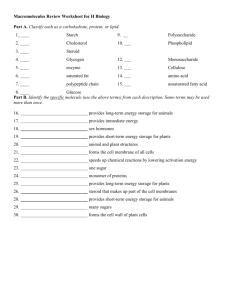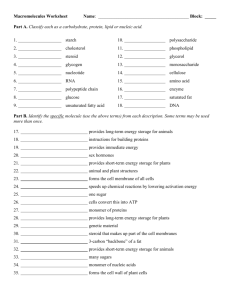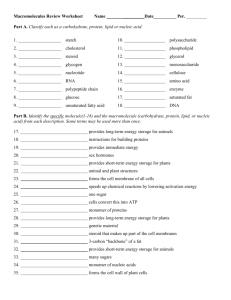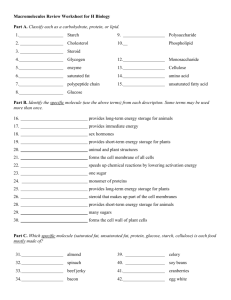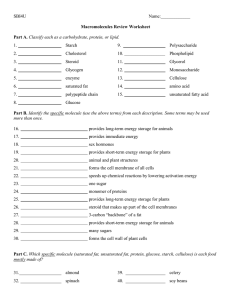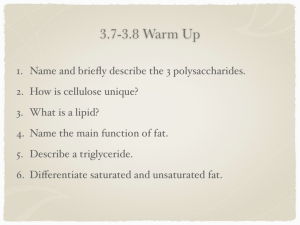Macromolecules Review Worksheet: Biology Practice
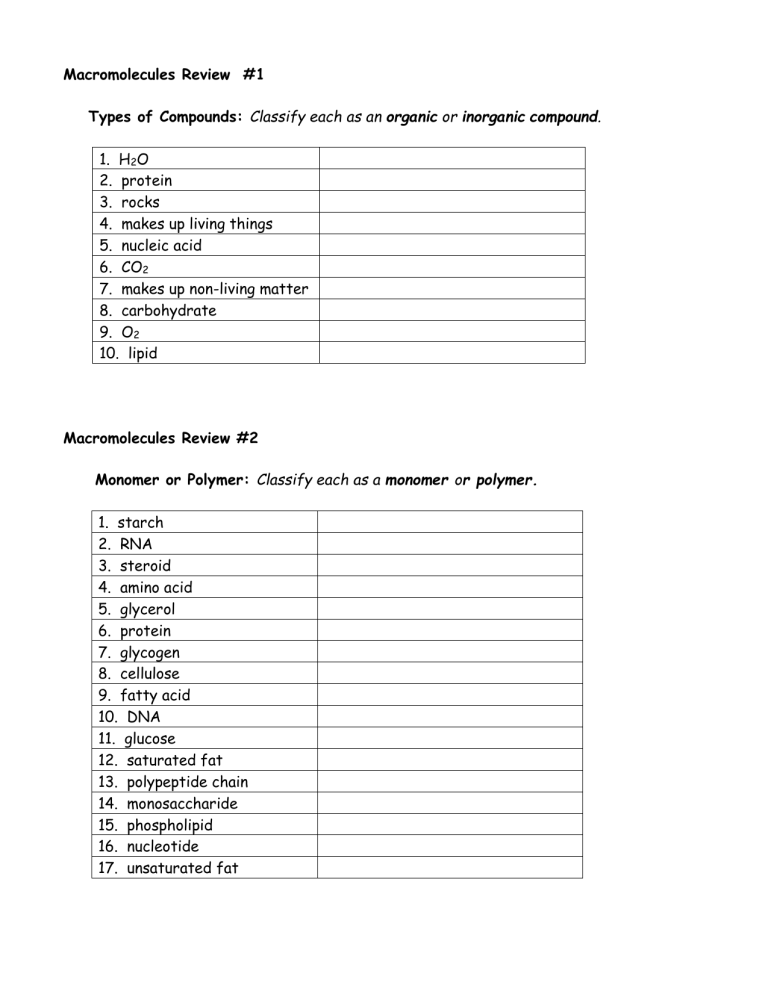
Macromolecules Review #1
Types of Compounds: Classify each as an organic or inorganic compound.
1. H
2
O
2. protein
3. rocks
4. makes up living things
5. nucleic acid
6. CO
2
7. makes up non-living matter
8. carbohydrate
9. O
2
10. lipid
Macromolecules Review #2
Monomer or Polymer: Classify each as a monomer or polymer.
1. starch
2. RNA
3. steroid
4. amino acid
5. glycerol
6. protein
7. glycogen
8. cellulose
9. fatty acid
10. DNA
11. glucose
12. saturated fat
13. polypeptide chain
14. monosaccharide
15. phospholipid
16. nucleotide
17. unsaturated fat
Macromolecules Review #3
Carbohydrates: Classify each as glucose, glycogen, starch or cellulose.
Write ALL possibilities.
1. short-term storage
2. found in plants
3. found in animals
4. used for quick energy
5. makes up plant structures
6. also known as “fiber”
Macromolecules Review #4
Lipids: Classify each as saturated fat, unsaturated fat, phospholipid, steroid.
Write ALL possibilities.
1. found in animals
2. found in plants
3. long-term energy storage
4. chemical signals
5. make up cell membranes
6. cholesterol
Macromolecules Review #5
Classify each as carbohydrate (C), protein (P), lipid (L), nucleic acid (NA)
1. starch
2. cholesterol
10. polysaccharide
11. phospholipid
3. steroid
4. glycogen
5. nucleotide
6. RNA
12. glycerol
13. monosaccharide
14. cellulose
15. amino acid
7. polypeptide chain
8. glucose
9. unsaturated fat
16. enzyme
17. saturated fat
18. DNA
Macromolecules Review #6
Identify the specific molecule (use terms from A) from each description. Some terms may be used more than once. polypeptide, cellulose, nucleotide, polysaccharide, glycogen, glycerol, cholesterol,
DNA, RNA, unsaturated fat, saturated fat, amino acid, glucose, monosaccharide, enzyme, phospholipid, protein, steroid, carbohydrate
1. provides long-term energy storage for animals
2. instructions for building proteins
3. provides quick energy
4. sex hormones
5. provides short-term energy for plants
6. forms plant and animal structures
7. forms membranes of all cells
8. speeds up chemical reactions
9. single sugar
10. converted by cells into ATP
11. monomer of proteins
12. provides long-term energy storage for plants
13. genetic material
14. steroid that is part of cell membranes
15. 3-carbon backbone of a fat
16. provides short-term energy storage for animals
17. many sugars
18. monomer of nucleic acids
19. forms the cell wall of plant cells
20. another name for protein
Macromolecules #7
State whether each is found in animals, plants or both.
1. starch
2. polysaccharide
3. steroid
4. glycogen
5. glucose
6. RNA
7. saturated fat
8. protein
9. DNA
10. phospholipid
11. enzyme
12. monosaccharide
13. cellulose
14. amino acid
Macromolecules #8
Which molecule is described. Write ALL possibilities.
glucose, glycogen, starch, cellulose, unsaturated fat
RNA, DNA, protein, saturated fat, phospholipid
1. made of glycerol and fatty acids
2. made of carbon, hydrogen and oxygen only
3. contains nitrogen
4. used to build muscle
5. quick boost of energy
6. stored energy
7. required to make protein
8. allows materials in and out of cells
9. makes hair, skin and nails
10. composed of nucleotides
Enzyme Review #1
Organic Molecule Review #4
Identify the Unknown samples
Unknown Elements Molecular
Sample
A
Contained Characteristics
C, H, O and N Polymer, very large molecules
B
C
C, H and O Very little oxygen, lots of Hydrogen
C, H and O Twice as much hydrogen as oxygen
Organic Compound
A _______________________
B _______________________
C _______________________
Reason
____________________________
___________________________
_____________________________
Organic Molecule Review #1
Fill in the table for nucleic acids:
Fill in the table for proteins:
Organic Molecule Review #2:
Fill in the table for lipids:
Fill in the table for carbohydrates:
Organic Molecule Review #3:
Name the 4 types of organic molecules:
Name the 6 elements found in living things:
_________________________________________
Enzyme Review #2
